stop start MITSUBISHI L200 2014 (in English) Service Manual
[x] Cancel search | Manufacturer: MITSUBISHI, Model Year: 2014, Model line: L200, Model: MITSUBISHI L200 2014Pages: 362, PDF Size: 20.97 MB
Page 297 of 362
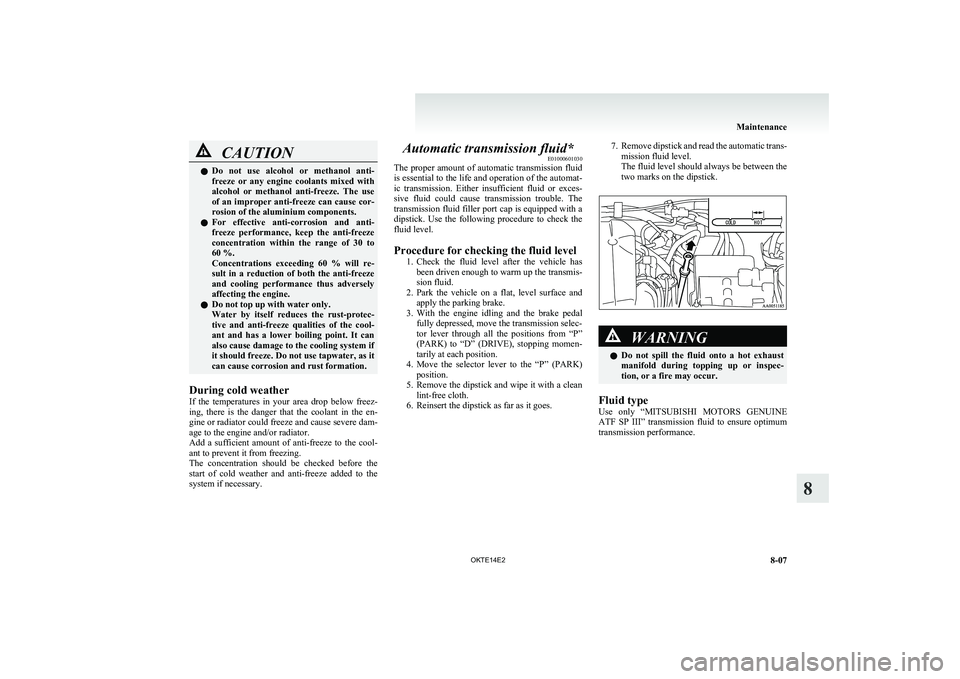
CAUTIONlDo not use alcohol or methanol anti-
freeze or any engine coolants mixed with
alcohol or methanol anti-freeze. The use
of an improper anti-freeze can cause cor-
rosion of the aluminium components.
l For effective anti-corrosion and anti-
freeze performance, keep the anti-freeze
concentration within the range of 30 to
60 %.
Concentrations exceeding 60 % will re-
sult in a reduction of both the anti-freeze
and cooling performance thus adversely
affecting the engine.
l Do not top up with water only.
Water by itself reduces the rust-protec-
tive and anti-freeze qualities of the cool-
ant and has a lower boiling point. It can
also cause damage to the cooling system if
it should freeze. Do not use tapwater, as it
can cause corrosion and rust formation.
During cold weather
If the temperatures in your area drop below freez-
ing, there is the danger that the coolant in the en-
gine or radiator could freeze and cause severe dam-
age to the engine and/or radiator.
Add a sufficient amount of anti-freeze to the cool-
ant to prevent it from freezing.
The concentration should be checked before the
start of cold weather and anti-freeze added to the
system if necessary.
Automatic transmission fluid* E01000601030
The proper amount of automatic transmission fluid
is essential to the life and operation of the automat-
ic transmission. Either insufficient fluid or exces-
sive fluid could cause transmission trouble. The
transmission fluid filler port cap is equipped with a
dipstick. Use the following procedure to check the
fluid level.
Procedure for checking the fluid level 1.Check the fluid level after the vehicle has
been driven enough to warm up the transmis-
sion fluid.
2. Park the vehicle on a flat, level surface and
apply the parking brake.
3. With the engine idling and the brake pedal
fully depressed, move the transmission selec-
tor lever through all the positions from “P”
(PARK) to “D” (DRIVE), stopping momen-
tarily at each position.
4. Move the selector lever to the “P” (PARK)
position.
5. Remove the dipstick and wipe it with a clean
lint-free cloth.
6. Reinsert the dipstick as far as it goes.7. Remove dipstick and read the automatic trans-
mission fluid level.
The fluid level should always be between the
two marks on the dipstick.WARNINGl Do not spill the fluid onto a hot exhaust
manifold during topping up or inspec-
tion, or a fire may occur.
Fluid type
Use only “ MITSUBISHI MOTORS GENUINE
ATF SP III” transmission fluid to ensure optimum
transmission performance.
Maintenance
8-07
OKTE14E2
8
Page 300 of 362
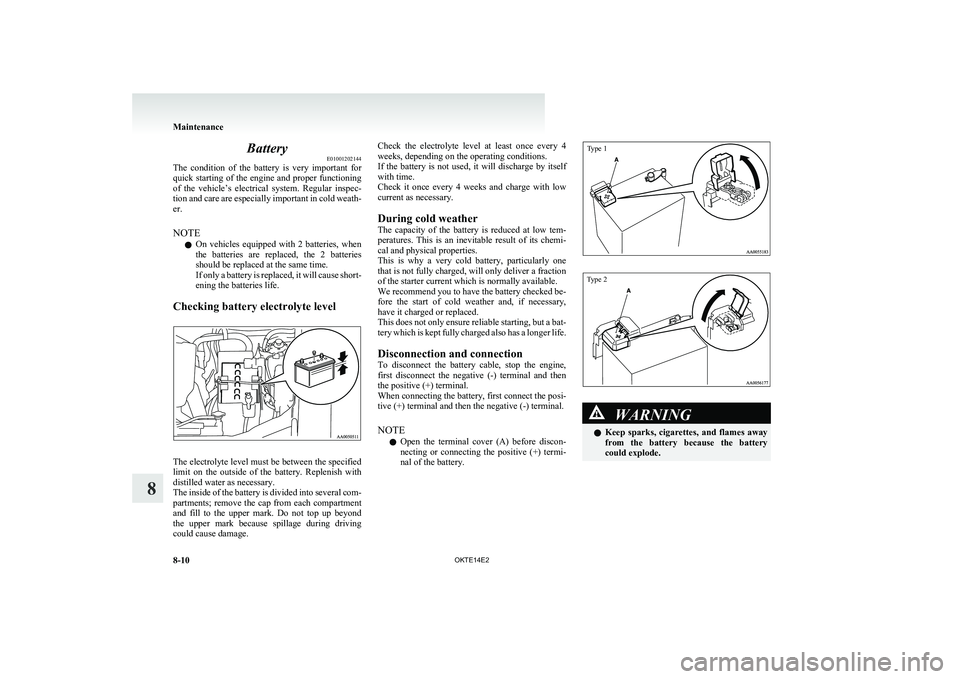
BatteryE01001202144
The condition of the battery is very important for
quick starting of the engine and proper functioning
of the vehicle’s electrical system. Regular inspec-
tion and care are especially important in cold weath-
er.
NOTE l On vehicles equipped with 2 batteries, when
the batteries are replaced, the 2 batteries
should be replaced at the same time.
If only a battery is replaced, it will cause short-
ening the batteries life.
Checking battery electrolyte level
The electrolyte level must be between the specified
limit on the outside of the battery. Replenish with
distilled water as necessary.
The inside of the battery is divided into several com-
partments; remove the cap from each compartment
and fill to the upper mark. Do not top up beyond
the upper mark because spillage during driving
could cause damage.
Check the electrolyte level at least once every 4
weeks, depending on the operating conditions.
If the battery is not used, it will discharge by itself
with time.
Check it once every 4 weeks and charge with low
current as necessary.
During cold weather
The capacity of the battery is reduced at low tem-
peratures. This is an inevitable result of its chemi-
cal and physical properties.
This is why a very cold battery, particularly one
that is not fully charged, will only deliver a fraction
of the starter current which is normally available.
We recommend you to have the battery checked be-
fore the start of cold weather and, if necessary,
have it charged or replaced.
This does not only ensure reliable starting, but a bat-
tery which is kept fully charged also has a longer life.
Disconnection and connection
To disconnect the battery cable, stop the engine,
first disconnect the negative (-) terminal and then
the positive (+) terminal.
When connecting the battery, first connect the posi-
tive (+) terminal and then the negative (-) terminal.
NOTE l Open the terminal cover (A) before discon-
necting or connecting the positive (+) termi-
nal of the battery.Type 1Type 2
WARNINGl Keep sparks, cigarettes, and flames away
from the battery because the battery
could explode.
Maintenance
8-10 OKTE14E2
8
Page 307 of 362
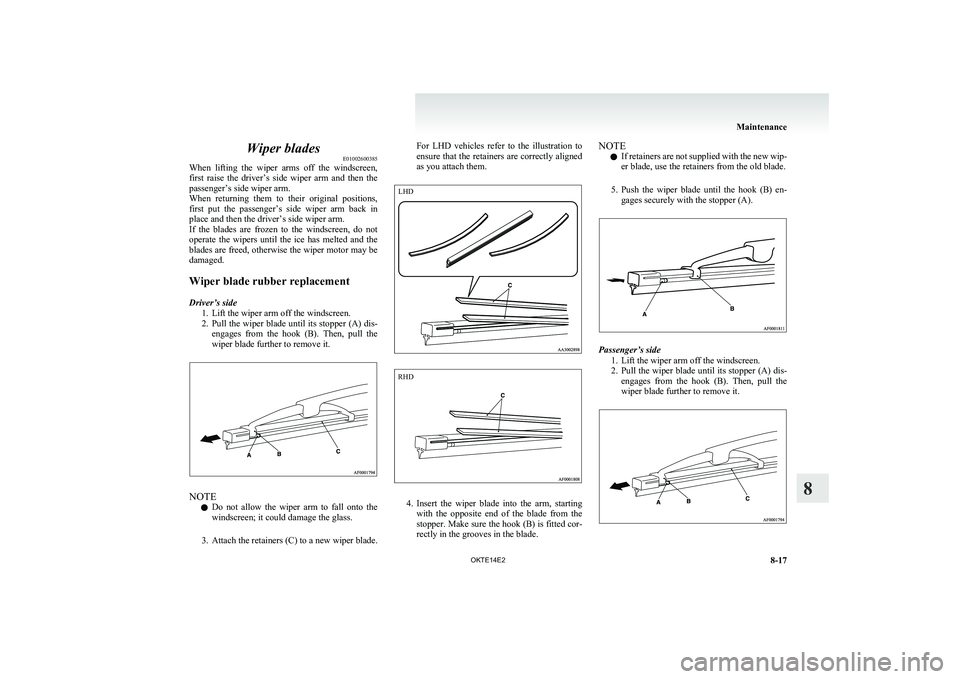
Wiper bladesE01002600385
When lifting the wiper arms off the windscreen,
first raise the driver’s side wiper arm and then the
passenger’s side wiper arm.
When returning them to their original positions,
first put the passenger’s side wiper arm back in
place and then the driver’s side wiper arm.
If the blades are frozen to the windscreen, do not
operate the wipers until the ice has melted and the
blades are freed, otherwise the wiper motor may be
damaged.
Wiper blade rubber replacement
Driver’s side 1. Lift the wiper arm off the windscreen.
2. Pull the wiper blade until its stopper (A) dis-
engages from the hook (B). Then, pull the
wiper blade further to remove it.
NOTE
l Do not allow the wiper arm to fall onto the
windscreen; it could damage the glass.
3. Attach the retainers (C) to a new wiper blade.
For LHD vehicles refer to the illustration to
ensure that the retainers are correctly aligned
as you attach them.LHDRHD
4. Insert the wiper blade into the arm, starting
with the opposite end of the blade from the
stopper. Make sure the hook (B) is fitted cor-
rectly in the grooves in the blade.
NOTE
l If retainers are not supplied with the new wip-
er blade, use the retainers from the old blade.
5. Push the wiper blade until the hook (B) en-
gages securely with the stopper (A).
Passenger’s side
1. Lift the wiper arm off the windscreen.
2. Pull the wiper blade until its stopper (A) dis-
engages from the hook (B). Then, pull the
wiper blade further to remove it.
Maintenance
8-17
OKTE14E2
8
Page 308 of 362
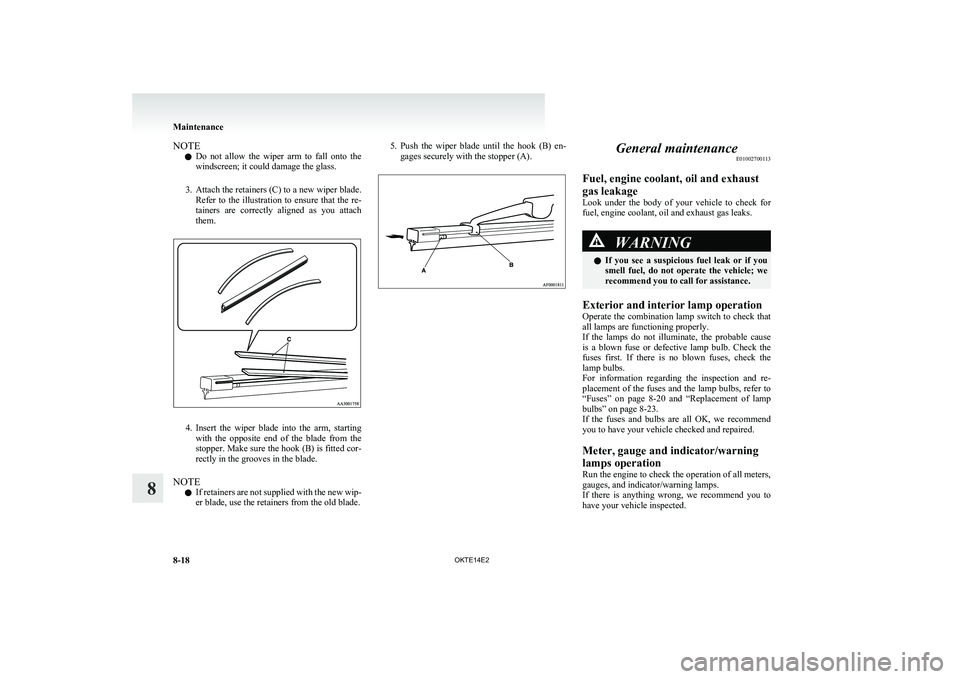
NOTEl Do not allow the wiper arm to fall onto the
windscreen; it could damage the glass.
3. Attach the retainers (C) to a new wiper blade.
Refer to the illustration to ensure that the re-
tainers are correctly aligned as you attach
them.
4. Insert the wiper blade into the arm, starting
with the opposite end of the blade from the
stopper. Make sure the hook (B) is fitted cor-
rectly in the grooves in the blade.
NOTE l If retainers are not supplied with the new wip-
er blade, use the retainers from the old blade.
5. Push the wiper blade until the hook (B) en-
gages securely with the stopper (A).General maintenance E01002700113
Fuel, engine coolant, oil and exhaust
gas leakage
Look under the body of your vehicle to check for
fuel, engine coolant, oil and exhaust gas leaks.WARNINGl If you see a suspicious fuel leak or if you
smell fuel, do not operate the vehicle; we
recommend you to call for assistance.
Exterior and interior lamp operation
Operate the combination lamp switch to check that
all lamps are functioning properly.
If the lamps do not illuminate, the probable cause
is a blown fuse or defective lamp bulb. Check the
fuses first. If there is no blown fuses, check the
lamp bulbs.
For information regarding the inspection and re-
placement of the fuses and the lamp bulbs, refer to
“ Fuses” on page 8-20 and “Replacement of lamp
bulbs” on page 8-23.
If the fuses and bulbs are all OK, we recommend
you to have your vehicle checked and repaired.
Meter, gauge and indicator/warning
lamps operation
Run the engine to check the operation of all meters,
gauges, and indicator/warning lamps.
If there is anything wrong, we recommend you to
have your vehicle inspected.
Maintenance
8-18 OKTE14E2
8
Page 350 of 362
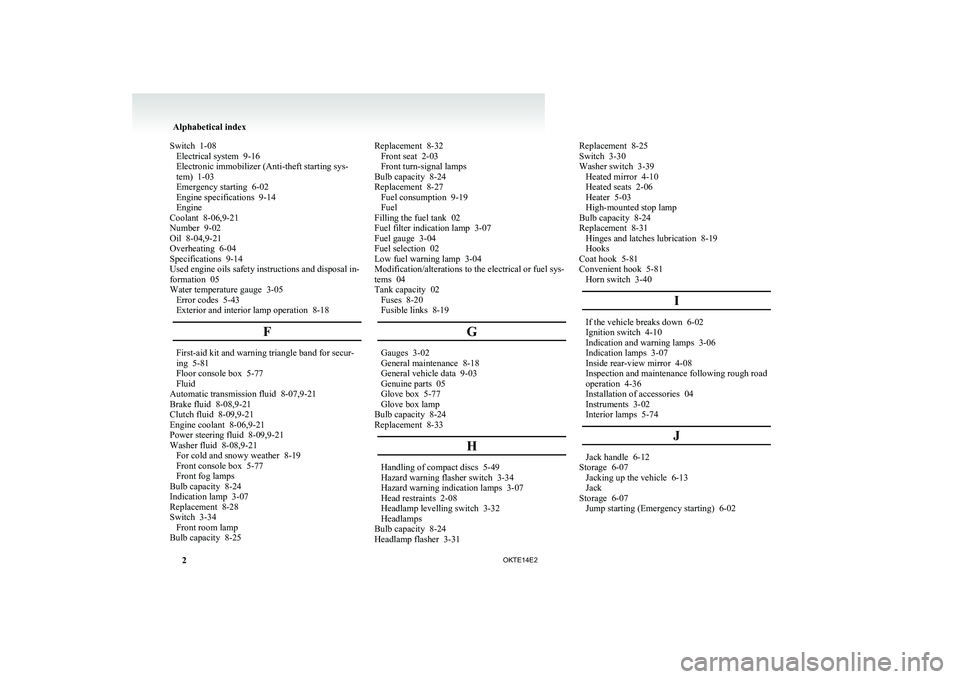
Switch 1-08
Electrical system 9-16
Electronic immobilizer (Anti-theft starting sys-
tem) 1-03
Emergency starting 6-02
Engine specifications 9-14
Engine
Coolant 8-06,9-21
Number 9-02
Oil 8-04,9-21
Overheating 6-04
Specifications 9-14
Used engine oils safety instructions and disposal in-
formation 05
Water temperature gauge 3-05 Error codes 5-43
Exterior and interior lamp operation 8-18
FFirst-aid kit and warning triangle band for secur-
ing 5-81
Floor console box 5-77
Fluid
Automatic transmission fluid
8-07,9-21
Brake fluid 8-08,9-21
Clutch fluid 8-09,9-21
Engine coolant 8-06,9-21
Power steering fluid 8-09,9-21
Washer fluid 8-08,9-21 For cold and snowy weather 8-19
Front console box 5-77
Front fog lamps
Bulb capacity 8-24
Indication lamp 3-07
Replacement 8-28
Switch 3-34 Front room lamp
Bulb capacity 8-25 Replacement 8-32
Front seat 2-03
Front turn-signal lamps
Bulb capacity
8-24
Replacement 8-27 Fuel consumption 9-19
Fuel
Filling the fuel tank 02
Fuel filter indication lamp 3-07
Fuel gauge 3-04
Fuel selection 02
Low fuel warning lamp 3-04
Modification/alterations to the electrical or fuel sys-
tems 04
Tank capacity 02 Fuses 8-20
Fusible links 8-19
G Gauges 3-02
General maintenance
8-18
General vehicle data 9-03
Genuine parts 05
Glove box 5-77
Glove box lamp
Bulb capacity 8-24
Replacement 8-33
H Handling of compact discs 5-49
Hazard warning flasher switch 3-34
Hazard warning indication lamps
3-07
Head restraints 2-08
Headlamp levelling switch 3-32
Headlamps
Bulb capacity 8-24
Headlamp flasher 3-31 Replacement 8-25
Switch 3-30
Washer switch 3-39
Heated mirror 4-10
Heated seats 2-06
Heater 5-03
High-mounted stop lamp
Bulb capacity
8-24
Replacement 8-31 Hinges and latches lubrication 8-19
Hooks
Coat hook 5-81
Convenient hook 5-81 Horn switch 3-40
I If the vehicle breaks down 6-02
Ignition switch 4-10
Indication and warning lamps
3-06
Indication lamps 3-07
Inside rear-view mirror 4-08
Inspection and maintenance following rough road
operation 4-36
Installation of accessories 04
Instruments 3-02
Interior lamps 5-74
J Jack handle 6-12
Storage 6-07 Jacking up the vehicle
6-13
Jack
Storage 6-07 Jump starting (Emergency starting) 6-02 Alphabetical index
2 OKTE14E2
Page 352 of 362
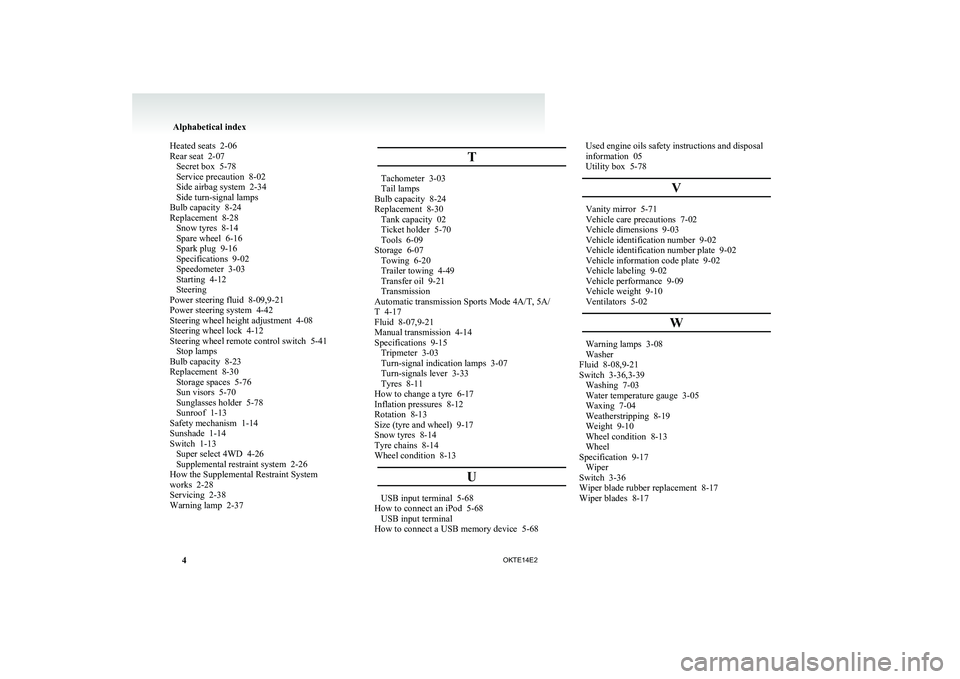
Heated seats 2-06
Rear seat 2-07
Secret box 5-78
Service precaution
8-02
Side airbag system 2-34
Side turn-signal lamps
Bulb capacity 8-24
Replacement 8-28 Snow tyres 8-14
Spare wheel 6-16
Spark plug 9-16
Specifications 9-02
Speedometer 3-03
Starting 4-12
Steering
Power steering fluid 8-09,9-21
Power steering system 4-42
Steering wheel height adjustment 4-08
Steering wheel lock 4-12
Steering wheel remote control switch 5-41 Stop lamps
Bulb capacity 8-23
Replacement 8-30 Storage spaces 5-76
Sun visors 5-70
Sunglasses holder 5-78
Sunroof 1-13
Safety mechanism 1-14
Sunshade 1-14
Switch 1-13 Super select 4WD 4-26
Supplemental restraint system 2-26
How the Supplemental Restraint System
works 2-28
Servicing 2-38
Warning lamp 2-37 TTachometer 3-03
Tail lamps
Bulb capacity
8-24
Replacement 8-30 Tank capacity 02
Ticket holder 5-70
Tools 6-09
Storage 6-07 Towing 6-20
Trailer towing 4-49
Transfer oil 9-21
Transmission
Automatic transmission Sports Mode 4A/T, 5A/
T 4-17
Fluid 8-07,9-21
Manual transmission 4-14
Specifications 9-15 Tripmeter 3-03
Turn-signal indication lamps 3-07
Turn-signals lever 3-33
Tyres 8-11
How to change a tyre 6-17
Inflation pressures 8-12
Rotation 8-13
Size (tyre and wheel) 9-17
Snow tyres 8-14
Tyre chains 8-14
Wheel condition 8-13
U USB input terminal 5-68
How to connect an iPod 5-68 USB input terminal
How to connect a USB memory device
5-68Used engine oils safety instructions and disposal
information 05
Utility box 5-78
V Vanity mirror 5-71
Vehicle care precautions
7-02
Vehicle dimensions 9-03
Vehicle identification number 9-02
Vehicle identification number plate 9-02
Vehicle information code plate 9-02
Vehicle labeling 9-02
Vehicle performance 9-09
Vehicle weight 9-10
Ventilators 5-02
W Warning lamps 3-08
Washer
Fluid 8-08,9-21
Switch 3-36,3-39 Washing 7-03
Water temperature gauge
3-05
Waxing 7-04
Weatherstripping 8-19
Weight 9-10
Wheel condition 8-13
Wheel
Specification 9-17 Wiper
Switch 3-36
Wiper blade rubber replacement 8-17
Wiper blades 8-17 Alphabetical index
4 OKTE14E2